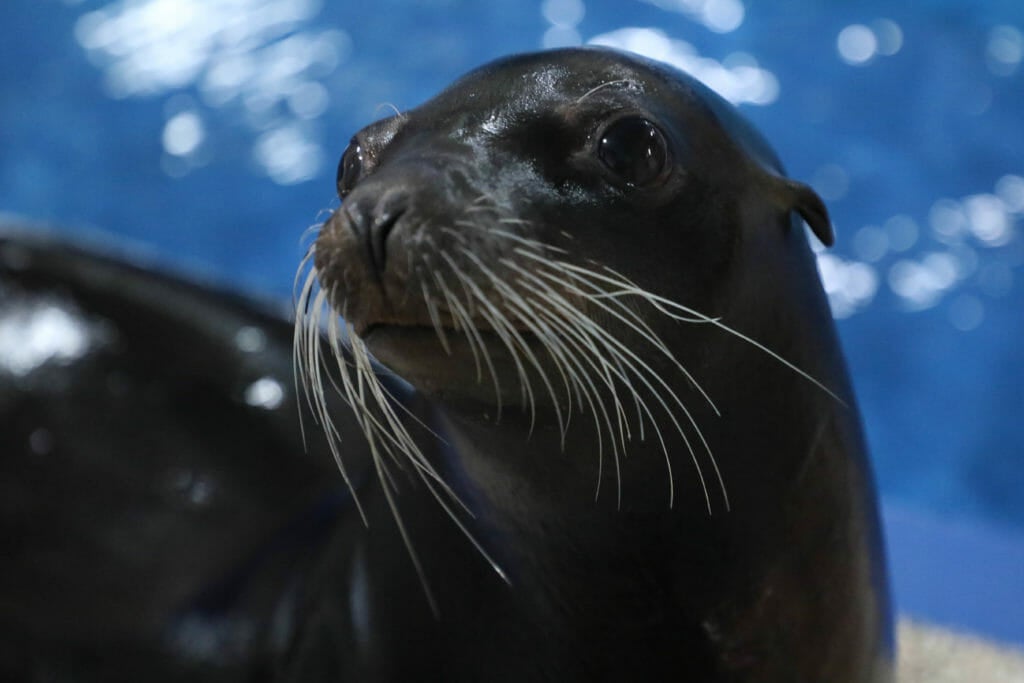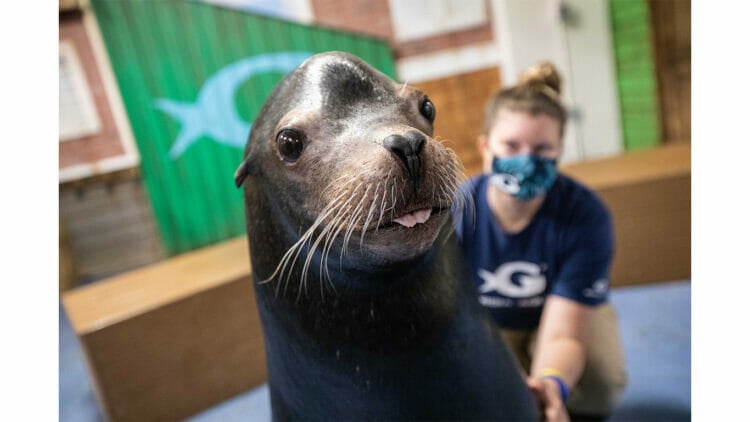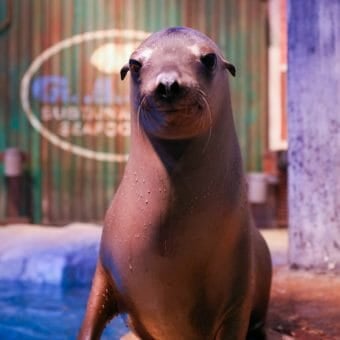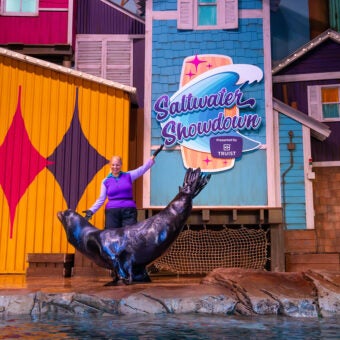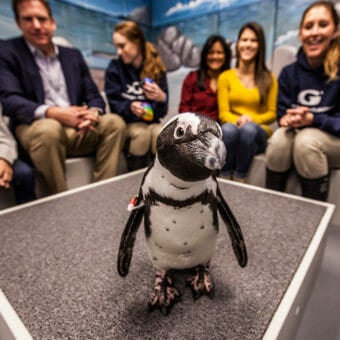-
Size
6-8 feet (2-2.4 m), 220-770 (100-350 kg) lbs. -
Diet
Squid, anchovy, rockfish, whiting and mackerel -
Range
Eastern Pacific Ocean -
Habitat
Near-shore waters
Physical Characteristics
- The maximum length is 6.6 feet (2 m) for females and 7.8 feet (2.4 m) for males.
- Common weight is about 220 lbs. (100 kg) for females and 770 lbs. (350 kg) for males.
- The maximum weight for males is 858 lbs. (390 kg). The maximum weight for females is 242 lbs. (110 kg).
- The average weight at birth is 13-20 lbs. (6-9 kg).
- The average length at birth is 30 inches (75 cm).
Flippers
- Two long, powerful, wing-like front flippers with short claws and two smaller rear flippers.
- Uses front flippers for propulsion and back flippers to steer while swimming.
- Rotates all four flippers underneath the body to walk on land.
- Flippers are supported by a skeletal structure similar to the bones in a human hand.
- May hold flippers out of the water to thermoregulate.
Body/Fur/Whiskers
- Stiff, thick whiskers, or “vibrissae,” made of keratin found around the muzzle. Help to feel the shape and size of objects and detect vibrations and sounds.
- Female coloration is lighter brown while males are typically darker brown, though males range in color from light brown to black. The fur on the male’s head may become lighter with age and the coat appears darker when wet.
- Males develop a bony bump on their head known as a sagittal crest at approximately five years of age.
- Pups are dark brown in color at birth, then shed juvenile fur and grow adult fur at 4-6 months of age.
- Two layers of fur – outer guard hairs and an inner underfur.
- Does not molt annually, but instead sheds and replaces fur all year long.
- Blubber helps keep sea lions warm.
- Male has a larger, thicker body shape than female.
Vision/Eyes
- Large eyes with excellent vision both in and out of the water and in low-light conditions.
Hearing/Ears
- Member of the family Otariidae, or “eared seals,” and therefore has small, external ear flaps, or “pinnae” (as opposed to a “true seal,” a member of family Phocidae, which has only small ear holes).
- Can hear above and below water.
Smell
- A well-developed sense of smell on land, but cannot smell underwater.
- Males may use smell to detect a female ready to mate.
- Mother and pup may use smell and vocalizations to identify one another.
Animal Fact
California sea lions’ whiskers can detect vibrations under water.
Diet / Feeding
- Opportunistic feeder; feeds mainly at upwelling areas.
- Diet primarily consists of squid, anchovy, rockfish, whiting and mackerel, though this may vary among populations and throughout their range.
- 34-38 cone-shaped teeth and four canine teeth; sea lions catch their food with their teeth and then swallow it whole.
- Adults eat an estimated 5-8% of their body weight every day.
- Males do not eat during the breeding season.
- May hunt alone or cooperatively; males may gather at the mouths of freshwater rivers for fish.
- May feed cooperatively with cetaceans and seabirds.
- May seize fish from fishing lines and nets.
Range / Habitat
- Occurs in the Eastern Pacific from Prince William Sound, Alaska to the southern tip of Mexico.
- Found in near-shore waters, on the shores of islands and along the mainland on a variety of substrates including beaches, rocky platforms and outcroppings, and man-made structures.
Reproduction & Growth
- Both sexes reach sexual maturity by 4-5 years of age.
- Breed mainly at Channel Islands and islands along the northern Pacific coast of Baja California as well as in the Gulf of California.
- Mating occurs from late spring to early fall; most births occur in June.
- Males form groups of females called rookeries on beaches and compete with other males through physical display, vocalizations and combat to protect their territories.
- After the breeding season, some males migrate north while females remain relatively close to breeding areas.
- The gestation period lasts about 11 months, however, the California sea lion exhibits delayed implantation, meaning that, although the egg is fertilized at the time of mating, it does not implant and begin to develop until sometime in October. Therefore, females actually produce a pup in about 7-8 months.
- Females generally give birth to a single pup. Nursing lasts about eight days, then the mother will forage for 2-3 days at a time away from the pup, before returning to continue nursing.
- Females may wean pups at six months of age, but pups may continue to nurse for up to a year or more.
- Females come into heat about two weeks after giving birth; mating typically occurs about 15-30 days after giving birth.
Conservation Status
- “Least Concern” on the IUCN Red List.
Additional Information
Lifespan
- The median lifespan for California sea lions in their natural habitat is 7.7-11.5 years.
- The median lifespan for California sea lions in human care is 23.5 years.
- The oldest sea lion recorded in human care was 31 years old.
Social Units/Behavior
- Sea lions are social animals.
- Hundreds may form groups called colonies at haul-out sites or at the surface of the water, floating in “rafts.”
- Vocalize through barks, growls, honks and clicks.
- May jump out of the water, a behavior known as “porpoising,” or surf in the waves.
Swimming/Diving
- Fastest of all the sea lion species.
- Reported swim speed between 6-8 mph (10-13 kph); maximum swim speed of 25 mph (40 kph) for a short distance.
- Average dive length of 1.5-2.8 minutes; maximum dive length of about 10 minutes.
- Average dive depth of 66-164 feet (20-50 m); maximum dive depth of about 900 feet (274 m).
Sources
- www.ammpa.org
- www.iucnredlist.org
- www.marinemammalcenter.org
- Guide to Marine Mammals of the World, Reeves
Unique Gifts from Georgia Aquarium
Bring the memories home with you! Stop by our gift shop for all your sea lion gifts or shop online here.
